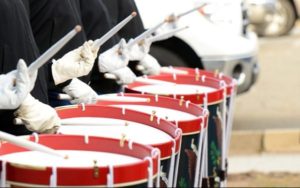
ピアノを右手だけで弾けるようになり、左手だけで弾けるようになったのに両手で弾くと上手くいかない。
そう悩んでいる方、心配いりません。ピアノを上手く弾ける方でも、両手で弾くと曲がリズムよく弾けなくなることがあります。
同時に演奏することは非常に難しいことなのです。片手の演奏が満足できるまで練習したら、それを両手で弾く練習をしなければいけません。右手と左手の技術を上手くまとめることができれば、様々な曲が弾けるようになるでしょう。
今回は両手で弾くため練習法を①~③まで紹介していきます。
毎回全てをやる必要はありません。自分にあった練習法を見つけてみてください。
ステップ① パートを細かく分ける 
最初はできるだけ曲を細かく分けていきましょう。
繰り返しますが、右手と左手を同時に演奏することは非常に難しいことです。一度に通して練習をしようとせず、自分なりに細かいパートを作っていってください。
キリの良いフレーズで区切って演奏することもいいですが、もっと区切りを細かくしたほうがより内容の濃い練習になります。
例えば1小節区切りにすることです。
特に長い曲になれば、果てしなく終わりが遠くに感じるかもしれませんが、技術的な面からもモチベーションの面からもこちらのほうが、かえって早く1曲を習得できることが多いです。1フレーズずつ練習して悪戦苦闘するよりは1小節ずつのほうが達成感も味わいやすくなるでしょう。
ステップ② リズムを理解する
次に右手と左手、それぞれのリズムの違いを理解していきます。
ほとんどのピアノの楽譜では、右手と左手のリズムが異なります。例えば右手は4分音符で左手が8分音符になっているものです。
まず最初に、楽譜に沿って右手と左手で違うリズムを刻む練習をしてみましょう。最近のはやりの打楽器であるカホンを叩くイメージです。
ピアノの鍵盤から一度離れてください。テーブルなどの平らな面を見つけ、手のひらでラップを刻んでみましょう。
左手で、曲の左手部分のリズムをタップします。次に、右手で、曲の右手部分のリズムを叩いていきます。先程の例で言えば、右手で4分音符のリズム、左手で8分音符のリズムで叩いてみてください。
楽譜を見て、右手のどの音と左手のどの音が同時に演奏されるかよく確認するようにしましょう。一見バラバラに見える右手と左手のパートでも、ある音で重なることがあるからです。
こちらも丁寧に行ってください。①と同じように1小節ずつに区切って行うことが理想です。
③全体像を頭にインプットする

最後はリズムに音を入れてパートの全体像を頭で理解し、自然にそのパートが頭の中で演奏されるようにしましょう。
やり方の一つとしては、片方の手の音を口で代用することです。
どういうことかというと、片方の手、例えば右手だけをピアノで演奏して、もう片方の左手のパートは音程を合わせて口で歌ってみましょう。歌詞がない場合はラララと歌ったり、鼻歌を歌うこともいいでしょう。
これにより、リズム感を捉えるとともに、曲やフレーズの全体像を頭にインプットすることができます。

最後に
最初は両手で弾くことが難しくても、練習をすることで自然に演奏できるようになってきます。①細かく分ける、②リズムを掴む、③全体像をインプットする、この3つのステップをこなしていくことで、きっとどんなに難しい曲でも両手で弾けるようになるはずです。


コメントを残す